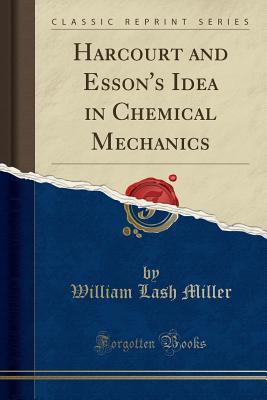Full Download Harcourt and Esson's Idea in Chemical Mechanics (Classic Reprint) - William Lash Miller | PDF
Related searches:
Chemical reactions - Department of Education and Training Victoria
Harcourt and Esson's Idea in Chemical Mechanics (Classic Reprint)
Harcourt and Esson's idea in chemical mechanics [electronic
Time and Chemical Change: The Development of Temporal
2776 722 119 2780 2585 2654 1468 2219 4852 1260 3587 3412 2040 4382 1402 3301 3196 2870 2959 4006 1539 63 3874 1345
Chemical kinetics in a long partnership, harcourt and william esson studied the rates of chemical reactions. Among the processes they investigated was the acid-catalyzed iodine clock reaction (iodide and hydrogen peroxide). Their work showed that the reaction's changing rate was proportional to the concentration of reactants present.
Because students rarely understand the concept of 'a substance' they don't see substances being changed.
Chemical engineering is a discipline influencing numerous areas of technology. In broad terms, chemical engineers conceive and design processes to produce,.
Mathema tical proc idea of chain reactions and their relation to the principle of photochemical equivalence began. Vernon harcourt: a founder of chemical kinetics and a friend.
The harcourt essen experiment the aim of this investigation is to: 1) find the rate equation for the reaction between hydrogen peroxide, potassium iodide and sulphuric acid by using the iodine stop clock method and plotting graphs of 1/time against concentration for each variable.
Further experiments led lavoisier to continuously modify his ideas, until it finally became clear to him that it was this new gas, and not fixed air, that was the active.
The rate law of a chemical reaction is a mathematical equation to describes the relationship between the reaction rate and the concentration of each reactant. In this experiment, the method of initial rates is used to determine the rate law of the harcourt-essen reaction.
This lesson is the first esson in the unit on energy discussing how energy is stored (potential energy, kinetic energy, etc). This lesson includes an investigation and a link to a video lesson on stored energy. These science lessons are aligned to the harcourt science curriculum including lessons,.
The iodine clock reaction (also known as the harcourt-esson reaction or the harcourt-essen reaction) is a classical chemical clock demonstration experiment to display chemical kinetics in action; it was discovered by hans heinrich landolt in 1886. Two colorless solutions are mixed and at first there is no visible reaction.
Start studying core practical 13b: investigating a clock reaction (harcourt-esson, iodine clock). Learn vocabulary, terms, and more with flashcards, games, and other study tools.
Harcourt later became lee's reader in chemistry at oxford, and esson became savilian professor of geometry at that university. In 1912, 47 years after their pioneering work on the rate laws of chemical kinetics, they again collaborated on a paper dealing with the variation of rate constants with the temperature.
In a long partnership, harcourt and william esson studied the rates of chemical reactions. Among the processes they investigated was the acid-catalyzed iodine clock reaction (iodide and hydrogen peroxide). Their work showed that the reaction's changing rate was proportional to the concentration of reactants present.
Date: introduction: the harcourt and esson experiment clock reaction.
Chemical ideas: harcourt-essen reaction: the iodine clock reaction (also known as the harcourt-essen reaction) is a classical chemical clock demonstration experiment to display chemical kinetics in action; it was discovered by hans heinrich landolt in 1886.
Harcourt and esson's idea in chemical mechanics [electronic resource] / by 1866-1940.
1914 – 1950: new materials and methods – organic and inorganic chemistry grow what what was neil bartlett able to do that was once thought impossible�.
In the realm of pure chemistry harcourt in 1866, aided by his mathematician colleague william esson, discovered independently of guldberg and waage the law of mass action in its simplest form: “the velocity of chemical change is directly proportional to the quantity of substance undergoing change.
The iodine clock reaction (also known as the harcourt–esson reaction) is a classic chemical clock experiment for displaying chemical kinetics in action; it was discovered by hans heinrich landolt in 1886. Two colorless solutions are mixed and at first there is no visible reaction.

Post Your Comments: